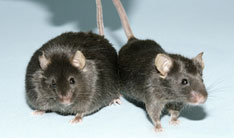
June 23, 2006
La Jolla, CA – Scientists at the Salk Institute for Biological Studies have identified a novel pathway that regulates the body’s ability to store or burn fat, a discovery that suggests new ways to reduce obesity, diabetes and other fat-related human diseases.
Genetically engineered mice, in which the pathway was constantly revved up, were protected from the ravages of a high-fat diet, the Salk team led by Marc Montminy, Ph.D., a professor in the Clayton Foundation Laboratories for Peptide Biology reports in this week’s issue of Science.
“These mice were able to deal with a high-fat diet much better than their normal counterparts,” Montminy says. “They stayed lean and were much more sensitive to insulin, although they ate more,” he adds.
In humans, a high-fat diet – one heavy on red and processed meats like hot dogs and sausages, refined grains, fried foods and sweets – increases the risk of fatty liver disease, which may eventually lead to type 2 diabetes, especially in people who are overweight and out of shape.
The engineered mice consumed an equally high-fat diet but did not gain weight, indicating that fat storage pathways can be tweaked. “Maybe the most amazing finding is that these mice are protected from fatty liver disease, a serious problem in obese individuals with insulin resistance,” says Montminy.
 Mice genetically engineered to express permanently elevated levels of TRB3 protein in fat tissue stay lean despite a high-fat diet that puts un-engineered mice on the brink of morbid obesity.
Mice genetically engineered to express permanently elevated levels of TRB3 protein in fat tissue stay lean despite a high-fat diet that puts un-engineered mice on the brink of morbid obesity.
Our body’s ability to store fat requires the activity of the enzyme acetyl-coenzyme A carboxylase, or ACC. When we fast, the body starts to burn fat while simultaneously shutting down ACC through a chemical modification called phosphorylation.
The Salk researchers found that a critical protein called TRB3 orchestrates a second chemical modification of ACC, known as ubiquitination, which gets rid of the enzyme altogether. “In this parallel pathway, TRB3 serves as a go-between for an enzyme that marks ACC for degradation,” says Jose Heredia, a graduate student in Montminy’s lab.
TRB3 levels in adipose tissue usually rise only during fasting, when ACC should be turned off. Heredia and co-first author Ling Qi, Ph.D., reasoned that keeping the TRB3 pathway artificially “on” during both fasting and feeding might melt away fat depots.
And that’s exactly what happened. Mice genetically engineered to express permanently elevated levels of TRB3 protein in fat tissue were 10-20 percent skinnier than normal mice. “Even when we put them on a high-fat diet, these mice just didn’t gain any weight,” says Qi. “Their physical activity was the same, but they were constantly burning fat.”
All this is good news for the fight against obesity and the disorders characterized by insulin-resistance known as “metabolic syndrome.” Most people with insulin resistance will develop type 2 diabetes within 10 years, unless they lose 5 to 7 percent of their body weight – about 10 to 15 pounds for someone weighing 200 pounds. Defining how molecules regulating fat storage interact could lead to novel measures to curb obesity.
Further evidence linking TRB3 to disease comes from recent findings from a team of Italian scientists who report that mutations in the human TRB3 gene are associated with several insulin resistance-related health problems, such as high insulin levels, high cholesterol, and cardiovascular disease.
Achieving a desired physiological outcome by manipulating basic biochemistry was clearly satisfying for Montminy. “What really made this an interesting story is that the molecular mechanism and the biology intersected since we were able to explain how TRB3 made the mice lean,” he reflects. “That doesn’t happen very often.”
Additional contributors to this study included assistant professor Robert Screaton, Ph.D., formerly at the Salk, now at Children’s Hospital of Eastern Ontario; Judith Y. Altarejos, Ph.D., Naomi Goebel, Michael Nelson, Ph.D., professor Ronald M. Evans, Ph.D., all at the Salk Institute; Sherry Niessen, Ian X. MacLeod, and Professor John Yates, Ph. D., from the Scripps Research Institute in La Jolla, California; Chong Wee Liew, Ph.D., and assistant professor Rohit Kulkarni, Ph.D., both at the Joslin Diabetes Center in Boston, Massachusetts; and James Bain, Ph.D., and professor Christopher Newgard, Ph.D., both at the Sarah W. Stedman Nutrition and Metabolism Center in Durham, North Carolina.
The Salk Institute for Biological Studies in La Jolla, California, is an independent nonprofit organization dedicated to fundamental discoveries in the life sciences, the improvement of human health and the training of future generations of researchers. Jonas Salk, M.D., whose polio vaccine all but eradicated the crippling disease poliomyelitis in 1955, opened the Institute in 1965 with a gift of land from the City of San Diego and the financial support of the March of Dimes.
Office of Communications
Tel: (858) 453-4100
press@salk.edu